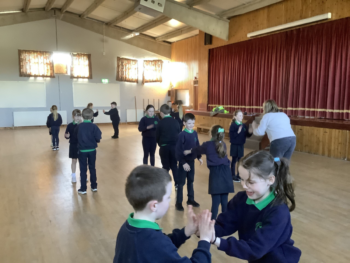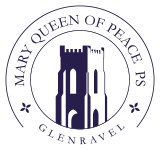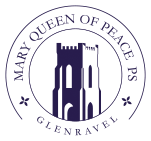PE: Dance
14th April 2025

We are committed to the development of the whole child in Mary Queen of Peace PS. By that we mean the spiritual, moral, social, academic, artistic, sporting and cultural development of every pupil. We use our School Development Plan to manage curriculum improvements. In the past we have worked on music and the Arts (printing and colleague). This year we developed a progressive dance programme from Primary 1 to 7, led by our PE Co-ordinator (Mrs Duffin); who planned the work in each year group (including the music) as well as training for all of the staff. Mrs Duffin worked closely with other schools as well as St. Mary’s University College (Belfast).
Our pupils would like to share the work in dance during Term II with you, including work in creative dancing and traditional dances from Ireland and around the world.
The school’s work in Dance was recognised by the Education Training Inspectorate (ETI) during their inspection of the school:
- The holistic development of the children is evident in the learning opportunities both within and beyond the curriculum. The commitment to developing the full range of each child’s talents is reflected in curriculum content that is informed and enhanced by the ethos, culture and traditions of the school and local area.
- During the dance lessons observed, the children are developing their physical skills such as balance, flexibility, co-ordination and stamina alongside expressive, social and imaginative skills, and they are able to show a sense of rhythm and sensitivity to music. They also have good opportunities to deepen their cultural and historical knowledge and understanding as they learn and perform traditional céilí dances and dances from other countries.
Report of a Primary Inspection: Mary Queen of Peace Primary School February 2025
Primary 1
Primary One started their dance programme by listening and counting the beat of the music. Both their warm up and cool down stretches were to eight beats. The children also learnt the importance of finding their own space bubble. After this Primary One practised moving/skipping in time to the music. Finally, it was the traditional dance part of the programme and the children performed their first folk dance Come to Me.
Primary 2
In Term 2 the boys and girls in Primary 2 studied and performed different examples of Creative and Folk Dances. The class looked closely at contrasting movements and how our body responses to music before they created their own individual dances to Incy Wincy Spider. Next, Primary 2 moved on to Folk Dances, the boys and girls loved dancing with their partners in time to the music – the favourite dance was The Cuckoo Dance, everyone was so excited for their chance to be the cuckoo in the middle.
Primary 3
Miss McLoughlin’s class: All the children have thoroughly enjoyed learning different styles of dance this year. It has been fun, inclusive of all abilities and a great opportunity for the children to learn about other cultural dances and to work collaboratively to achieve an end goal, the final dance. The class video showcases the Danish dance, The Shoemaker’s Dance. Firstly, the children warmed up by exploring body shapes which links to the current Maths Mastery topic- 2-D Shapes, while skipping towards their partner. Skipping is the main movement in the dance. Then the children practised their hand movements (circling forwards and backwards in counts of 3, pulling and clapping 3 times.) Once this was perfected, the pupils worked in pairs to skip clockwise for 8 and then anticlockwise for 8 counts. Finally, the class got into 3 groups to perform, The Shoemaker’s Dance.
Mrs McKeown’s class: the children have taken part in creative dance classes before moving on to folk dancing. The class learnt and performed the Harvest Time Jig. Primary 3 enjoyed the fun, exercise and teamwork.
Primary 4
Mrs O’Mullan’s class: P4 started with creative dance: producing light and heavy movements; slow and fast movements; interpreting the music and moving accordingly. The children worked in groups and made the word dance. Primary 4 then moved on to The Siege of Ennis, with our Irish dancers leading the way and helping guide their classmates. The pupils finished with a German folk dance, which was great fun. Primary 4 thoroughly enjoyed their dance lessons, with every child participating fully.
Mrs Sharkey’s class: The children started their dance programme by focussing on creative dance. The class experimented with shape, strong and light movements, as well as animal movements. Then the children learnt about traditional dances, starting with The Siege of Ennis, which was tricky in the beginning but fun when the class got the hang of it. Finally, in the international section, it was a German Clap Dance, which was lots of fun to practise and perform.
Primary 5
During Term 2, Primary 5 have enjoyed learning three dances. The class began the term learning the Ping Pong Jive which was a creative dance. The children learnt the steps and had fun using their bodies to move to the beat. The folk programme included Shoe the Donkey, which we performed on Green Day and The Hazelnut Dance, a traditional Romanian dance; both of which taught the children about partners in dancing performances.
Primary 6
Miss Walsh’s class: Primary 6 enjoyed learning both contemporary and creative/folk dances. The focus was on movement and space within contemporary dance; and Irish and Italian dances/songs in the folk dance lessons. Although the class made the moves look simple, they were fast paced and needed a lot of skill!
Mrs McAlister’s class: Primary 6 PE curriculum in Term II focuses on creative and contemporary/folk dance. The Irish folk dance was Stacks of Barley, while the European folk dance was La Vinca. Primary 6 thoroughly enjoyed this experience.
Primary 7
During Term 2, Primary 7 had the opportunity to experience both Creative and Folk dance. The creative dance was embraced well by everyone as it gave the pupils freedom to explore the main elements of this type of dance: body actions, levels, pathways and direction in unison and in canon. In folk dance, the pupils learnt two Irish folk dances: The Walls of Limerick and The Waves of Tory, as well as a French folk dance.
Enjoy the photos and given the dance film, which focuses on the Irish dimension.
Mrs Duffin
PE Co-ordinator






































